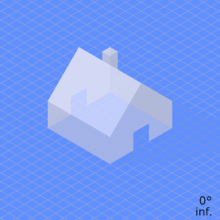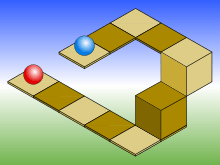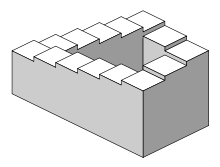Parallel projection
| Part of a series on |
| Graphical projection |
|---|
 |
Parallel projections have lines of projection that are parallel both in reality and in the projection plane.
Parallel projection corresponds to a perspective projection with an infinite focal length (the distance from the image plane to the projection point), or "zoom".
Within parallel projection there is an ancillary category known as "pictorials". Pictorials show an image of an object as viewed from a skew direction in order to reveal all three directions (axes) of space in one picture. Because pictorial projections innately contain this distortion, in the rote, drawing instrument for pictorials, some liberties may be taken for economy of effort and best effect.
Orthographic projection

The orthographic projection is derived from the principles of descriptive geometry, and is a type of parallel projection where the projection rays are perpendicular to the projection plane.[1] It is the projection type of choice for working drawings.
The term orthographic is also sometimes reserved specifically for depictions of objects where the axis or plane of the object is also parallel with the projection plane (paper on which the Orthographic or parallel projection is drawn.[1]
In multiview orthographic projection, up to six pictures of an object are produced, with each projection plane parallel to one of the coordinate axes of the object.
Pictorials
Axonometric projection
Axonometric projection is a type of orthographic projection where the plane or axis of the object depicted is not parallel to the projection plane,[2][3][4] such that multiple sides of an object are visible in the same image.[5] It is further subdivided into three groups: isometric, dimetric and trimetric projection, depending on the exact angle at which the view deviates from the orthogonal.[1][4] A typical characteristic of axonometric pictorials is that one axis of space is usually displayed as vertical.

Isometric projection
In isometric pictorials (for protocols see isometric projection), the most common form of axonometric projection,[3] the direction of viewing is such that the three axes of space appear equally foreshortened. There are two commonly used standards for creating scaled isometric drawings. An accurate drawing of a three-dimensional object projected isometrically would have its axis-parallel edges foreshortened by a factor of √2⁄3 ≈ 81.65%, but for convenience this is usually approximated as 3⁄4. That is, the length of an edge on a drawing of this type would be 3⁄4 of its length on a three-dimensional object. Alternatively, "full-size" isometric drawings may be made in which no foreshortening is shown: the length of an edge on a drawing is the same as its three-dimensional length.[6]
Dimetric projection
In dimetric pictorials (for protocols see dimetric projection), the direction of viewing is such that two of the three axes of space appear equally foreshortened, of which the attendant scale and angles of presentation are determined according to the angle of viewing; the scale of the third direction (vertical) is determined separately. Approximations are common in dimetric drawings.
Trimetric projection
In trimetric pictorials (for protocols see trimetric projection), the direction of viewing is such that all of the three axes of space appear unequally foreshortened. The scale along each of the three axes and the angles among them are determined separately as dictated by the angle of viewing. Approximations in trimetric drawings are common, and trimetric perspective is seldom used.[4]
Oblique projection
In oblique projections the parallel projection rays are not perpendicular to the viewing plane as with orthographic projection, but strike the projection plane at an angle other than ninety degrees.[1] In both orthographic and oblique projection, parallel lines in space appear parallel on the projected image. Because of its simplicity, oblique projection is used exclusively for pictorial purposes rather than for formal, working drawings. In an oblique pictorial drawing, the displayed angles among the axes as well as the foreshortening factors (scale) are arbitrary. The distortion created thereby is usually attenuated by aligning one plane of the imaged object to be parallel with the plane of projection thereby creating a true shape, full-size image of the chosen plane. Special types of oblique projections are military, cavalier and cabinet projection.[2]
Limitations


Objects drawn with parallel projection do not appear larger or smaller as they extend closer to or away from the viewer. While advantageous for architectural drawings, where measurements must be taken directly from the image, the result is a perceived distortion, since unlike perspective projection, this is not how our eyes or photography normally work. It also can easily result in situations where depth and altitude are difficult to gauge, as is shown in the illustration to the right.
In this isometric drawing, the blue sphere is two units higher than the red one. However, this difference in elevation is not apparent if one covers the right half of the picture, as the boxes (which serve as clues suggesting height) are then obscured.
This visual ambiguity has been exploited in op art, as well as "impossible object" drawings. M. C. Escher's Waterfall (1961), while not strictly using parallel projection, is a well-known example, in which a channel of water seems to travel unaided along a downward path, only to then paradoxically fall once again as it returns to its source. The water thus appears to disobey the law of conservation of energy. An extreme example is depicted in the film Inception, where by a forced perspective trick an immobile stairway changes its connectivity.
See also
References
- 1 2 3 4 Maynard, Patric (2005). Drawing distinctions: the varieties of graphic expression. Cornell University Press. p. 22. ISBN 0-8014-7280-6.
- 1 2 Desai, Apurva A. Computer Graphics. PHI Learning Pvt. Ltd. p. 232. ISBN 81-203-3524-4.
- 1 2 Godse, A. P. (1980). Computer graphics. Technical Publications. p. 29. ISBN 81-8431-558-9.
- 1 2 3 McReynolds, Tom; David Blythe (2005). Advanced graphics programming using openGL. Elsevier. p. 502. ISBN 1-55860-659-9.
- ↑ Mitchell, William; Malcolm McCullough (1994). Digital design media. John Wiley and Sons. p. 169. ISBN 0-471-28666-4.
- ↑ Davis, Thomas B.; Nelson, Carl A. (2003), Audel Mechanical Trades Pocket Manual (4th ed.), John Wiley & Sons, p. 65, ISBN 9780764541704.